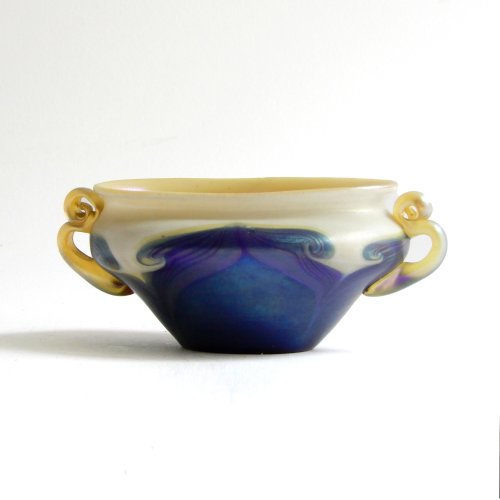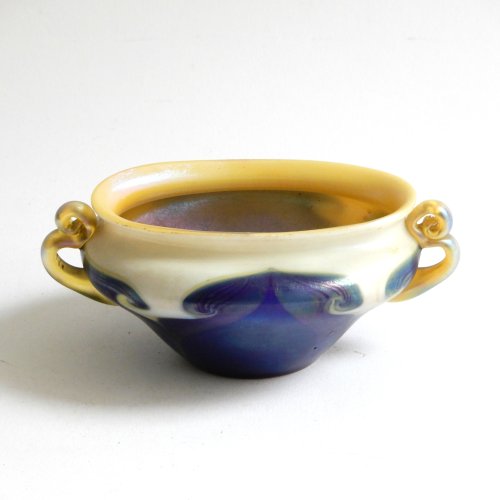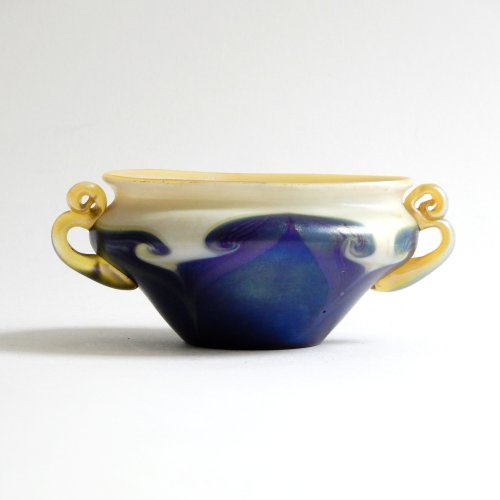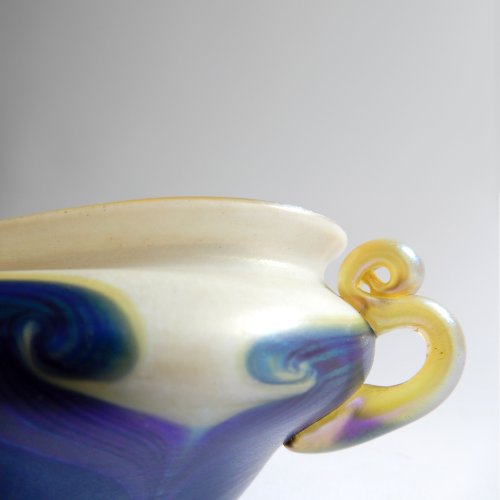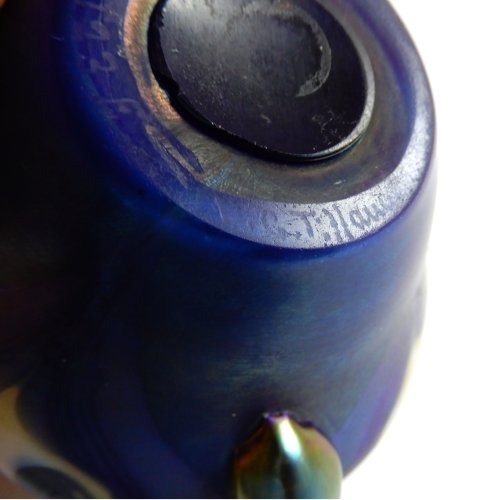Louis Comfort Tiffany (1848-1933) 'Favrile' glass vase with curled handles
About this piece
Iridescent glass vase with two gracefully curled handles and a rolled rim.
This is a studio design, a Favrile small vase by the renowned glass artist and designer Louis Comfort Tiffany (New York, 1848-1933).
He invented a special technique that allowed him to create glass resembling ancient glass, which was lightly iridescent and somewhat opaque, not completely transparent anymore. Additionally, it has a characteristic satin finish, and the colours flow into each other, combed together, or create a beautiful contrast, as is the case with this vase, with its creamy white and dark purple, which also consists of various shades of blue, purple, and a hint of yellow if you look closely. The inside of this vase is like mother-of-pearl, with a pink or yellow-golden glow depending on how the light falls on it. The handles are iridescent transparent yellow with a golden light, very refined and tasteful.
Tiffany's Favrile glass vases were actually a mix; the technique was based on that of Venetian glassmakers and was inspired by ancient Egyptian glass. Venetian glassmaker Antonio Salviati was an example for him, a student of Salviati, glass artist Andrea Boldini, is one of the glass artists who was working for Tiffany in the USA. Tiffany managed to blend five different colours alongside opal glass. He patented this 'Favrile' technique in 1894. Favrile is derived from the Latin 'Fabrilis,' meaning 'handmade.' Very fitting, as this vase is handmade and blown. Consequently, these vases were already costly to acquire at the time and still are. Such vases are still collected and included in many museum collections.
Each vase also has its own number. At least, that applies to the early studio designs of Louis C. Tiffany. Tiffany also created series designs with the Favrile technique, which were signed differently and often had a model number combined with another number or just a model number without a letter designation.
This vase is signed with "5723E, L.C. Tiffany, Favrile," the number corresponds to this unique vase, and the letter E, placed after the number, indicates that the vase was made in 1910.
Biography: Louis Comfort Tiffany (1848-1933)
Louis Comfort Tiffany (1848-1933) was a pioneer in the field of decorative arts and glass design, whose work profoundly influenced the American art world. Born on February 18, 1848, in New York City, he was the son of Charles Lewis Tiffany, the founder of the famous jewellery house Tiffany & Co. Although he was born into a wealthy family, Louis chose his own path and became an influential artist and designer.
Louis Comfort Tiffany began his career not in the glass industry, but as a painter. He studied under renowned artists George Inness in the United States and Léon Belly in Paris. In the 1870s, Tiffany travelled through Europe and North Africa, where he developed his interest in glass and decorative arts. His travels inspired him to experiment with different materials and techniques, which eventually led to his groundbreaking work in glass.
In 1879, Tiffany, along with several partners, founded the company Louis C. Tiffany and Associated Artists. This company specialized in interior design and created luxurious interiors for some of the wealthiest Americans of the time, including Mark Twain and Cornelius Vanderbilt. Tiffany's interest in glass continued to grow, and in 1885, he founded the Tiffany Glass Company, later known as Tiffany Studios.
One of Tiffany's most groundbreaking innovations was the development of Favrile glass. This glass, which he patented in 1894, was known for its unique iridescent quality, making it resemble ancient glass. Tiffany's Favrile glass quickly became famous and valued for its delicate colours and intricate designs. He used this technique not only for vases and other decorative objects but also for his famous stained glass windows and lamps. More detailed information about Favrile glass has been provided above.
Tiffany's work was widely praised and exhibited at international exhibitions, including the 1893 World's Fair in Chicago and the 1900 World's Fair in Paris. His designs were a perfect representation of the Art Nouveau movement, which emphasized natural forms and intricate details.
One of his most iconic creations is the Tiffany lamp, characterized by a leaded glass shade with colourful mosaics. These lamps quickly became a symbol of elegance and sophistication, and they remain highly sought after by collectors to this day.
In addition to his glasswork, Tiffany was also known for his monumental works in mosaic and stained glass windows for churches and public buildings. One of his most impressive projects was designing the stained glass windows for the Chapel of St. John the Divine in New York City.
Louis Comfort Tiffany was married twice and had four children. His first wife tragically passed away at a relatively young age in 1882. He led a life full of creativity and innovation, always seeking new ways to integrate beauty and art into everyday life. After his death on January 17, 1933, his influence remained palpable in the world of decorative arts. The name Tiffany is widely recognized, which is a significant achievement.
Today, Tiffany's works are exhibited in museums worldwide, including the Metropolitan Museum of Art in New York and the Musée d'Orsay in Paris. His legacy lives on in the timeless beauty of his designs and the lasting impact he has had on the art and design world.
Literature:
- Alastair Duncan, The Paris Salons, 1895-1914, Volume IV, Ceramics & Glass. Antique Collectors Club Limited, Suffolk, 1998. pp. 444-451
- Victor Arwas, Glass, Art Nouveau to Art Deco, Academy Editions London 1987. pp. 304-333
Condition
Excellence
Material:
Glass
Measurements:
Width: 13 cm
(5,12")
Height: 5,5 cm
(2,17")
Depth: 9 cm
(3,54")
Weight:
221 grams
(7,8oz)
Year:
1910
Origin:
U.S.A.
Artist / atelier:
Louis Comfort Tiffany,
